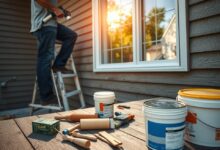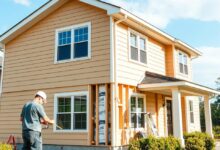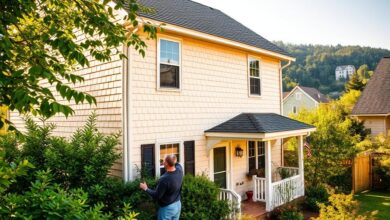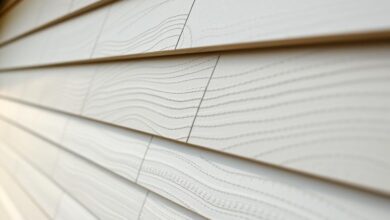Insulated Siding for Noise Reduction: A Comprehensive Review
In today’s world, noise reduction is a big deal for homeowners. This is true, even more so for those near highways or airports.
Insulated siding might be the answer. It makes homes look better and also blocks out outside noise.
This review dives into how insulated siding helps cut down on noise. It looks at how it boosts home insulation and makes life better.
Key Takeaways
- Insulated siding can greatly cut down outside noise.
- It makes homes look nicer.
- It adds an extra layer of insulation.
- It’s a budget-friendly way to reduce noise.
- It also makes homes more energy-efficient.
Understanding Noise Pollution and Home Insulation
It’s important to know where noise comes from to improve home insulation. Noise pollution can really hurt the quality of life in homes. We need to understand how outside noises affect our homes and how they move through our exteriors.
Common Sources of External Noise
Many things can make noise outside, like traffic, construction sites, and airports. These can make a lot of noise that disrupts our peace at home. Traffic noise is a big problem in cities, and construction sites bother people in cities and suburbs. Knowing where these noises come from is the first step to reducing them.
How Sound Travels Through Home Exteriors
Sound moves through the air and can get into homes through windows, doors, and exterior siding. The kind of siding and its materials affect how much sound gets in. For example, insulated siding can block more noise by adding an extra layer.
Insulated Siding for Noise Reduction: How It Works
Insulated siding helps block outside noise. It’s made with materials that keep homes warm and quiet. These materials absorb sound, making homes quieter.
Sound dampening materials are key. They turn sound into heat, which is lost, making homes quieter.
The Science Behind Sound Dampening Materials
These materials are often foam and vinyl. The foam traps air, which helps block sound. This makes homes quieter.
The density and thickness of these materials matter too. Thicker, denser materials block sound better.
Sound Transmission Class (STC) Ratings Explained
The Sound Transmission Class (STC) rating shows how well a material blocks sound. Ratings range from 0 to 100. Higher ratings mean better sound insulation.
For insulated siding, an STC rating of 50 or higher is good. This means it can block a lot of outside noise. Knowing STC ratings helps choose the right materials.
In short, insulated siding’s ability to block noise comes from its materials and STC ratings. Choosing siding with high STC ratings makes homes quieter.
Top Insulated Siding Products for Soundproofing
Soundproofing your home is easier with insulated siding products. There are many options to choose from. This section looks at top products like CertainTeed Monogram, James Hardie, Mastic SolarDefense, and ProVia CedarMAX.
CertainTeed Monogram Insulated Vinyl Siding
CertainTeed Monogram Insulated Vinyl Siding is known for its durability and looks. It has a foam backing for better insulation.
Features and Specifications
This siding is built to last and is easy to care for. It resists fading, cracking, and weather damage.
- Foam-backed insulation for improved thermal and sound insulation
- Durable vinyl exterior resistant to weathering
- Low maintenance requirements
Pros and Cons
CertainTeed Monogram siding is durable and looks great. But, it might cost more than other options.
| Pros | Cons |
|---|---|
| Durable and long-lasting | Higher upfront cost |
| Low maintenance | Limited color options |
| Effective insulation |
Noise Reduction Performance
CertainTeed Monogram Insulated Vinyl Siding reduces noise well. Homeowners notice less noise pollution.
James Hardie Insulated Fiber Cement Siding
James Hardie Insulated Fiber Cement Siding is known for its durability and resistance to damage.
Features and Specifications
This product combines fiber cement with insulation. It’s durable and energy-efficient.
- Insulated design for improved energy efficiency and soundproofing
- Durable fiber cement construction
- Resistance to fire, pests, and weathering
Pros and Cons
James Hardie siding is durable and resistant. But, it’s heavy and might need extra support.
| Pros | Cons |
|---|---|
| Highly durable and resistant | Heavy and may require additional support |
| Effective insulation and soundproofing | More expensive than some alternatives |
| Fire-resistant |
Noise Reduction Performance
James Hardie Insulated Fiber Cement Siding reduces noise well. Its dense construction and insulation help.
Mastic SolarDefense Insulated Siding
Mastic SolarDefense Insulated Siding offers energy efficiency and soundproofing. It’s a versatile choice for homeowners.
Features and Specifications
This siding has solar reflective technology. It helps reduce heat gain in summer and insulates well.
- Solar reflective technology for energy efficiency
- Insulated design for soundproofing and thermal insulation
- Durable construction
Pros and Cons
Mastic SolarDefense siding saves energy and is durable. But, availability and features may vary by region.
| Pros | Cons |
|---|---|
| Energy-efficient | Availability may vary |
| Effective soundproofing | May have higher upfront costs |
| Durable |
Noise Reduction Performance
Mastic SolarDefense Insulated Siding reduces noise well. Its insulated design and construction help.
ProVia CedarMAX Insulated Vinyl Siding
ProVia CedarMAX Insulated Vinyl Siding combines beauty, durability, and insulation.
Features and Specifications
This product looks like natural wood but is more durable and low maintenance.
- Insulated vinyl construction for improved thermal and sound insulation
- Durable and resistant to weathering
- Aesthetic appeal with various color and style options
Pros and Cons
ProVia CedarMAX siding looks great and insulates well. But, it might not be as durable as fiber cement.
| Pros | Cons |
|---|---|
| Attractive appearance | May not be as durable as fiber cement |
| Effective insulation | Limited by vinyl material characteristics |
| Low maintenance |
Noise Reduction Performance
ProVia CedarMAX Insulated Vinyl Siding reduces noise well. Its insulated vinyl construction helps.
Installation Considerations and Cost Analysis
Getting insulated siding installed right is key to its noise reduction. Homeowners need to think about a few things. They must decide if they should hire a pro or do it themselves.
Professional vs. DIY Installation
DIY installation can save money but needs a lot of skill and time. Professional installation is more expensive but ensures quality. It’s important to consider your skills and budget when choosing.
Average Costs and Return on Investment
The price of insulated siding changes based on the material and area size. On average, it costs between $10 and $20 per square foot. The ROI can be high, with energy savings and increased property value.
| Material | Cost per Square Foot | Average ROI |
|---|---|---|
| Vinyl Siding | $10 – $15 | 80% |
| Fiber Cement Siding | $15 – $20 | 85% |
Maintenance Requirements and Longevity
Insulated siding needs little upkeep, just occasional cleaning. Its lifespan varies by material. Vinyl siding lasts up to 30 years, while fiber cement can last longer. Regular checks can help it last even longer.
Conclusion
Insulated siding is a great choice for those wanting to cut down on noise. It works well and comes in many types. Homeowners can pick the right one for their home.
Soundproofing is key for a quiet home. Insulated siding is a good option. Products like CertainTeed Monogram and James Hardie are top choices.
Thinking about insulated siding? Look at the cost, how to install it, and upkeep. This way, you can make your home quieter and more comfortable. It’s a smart move for soundproofing.








